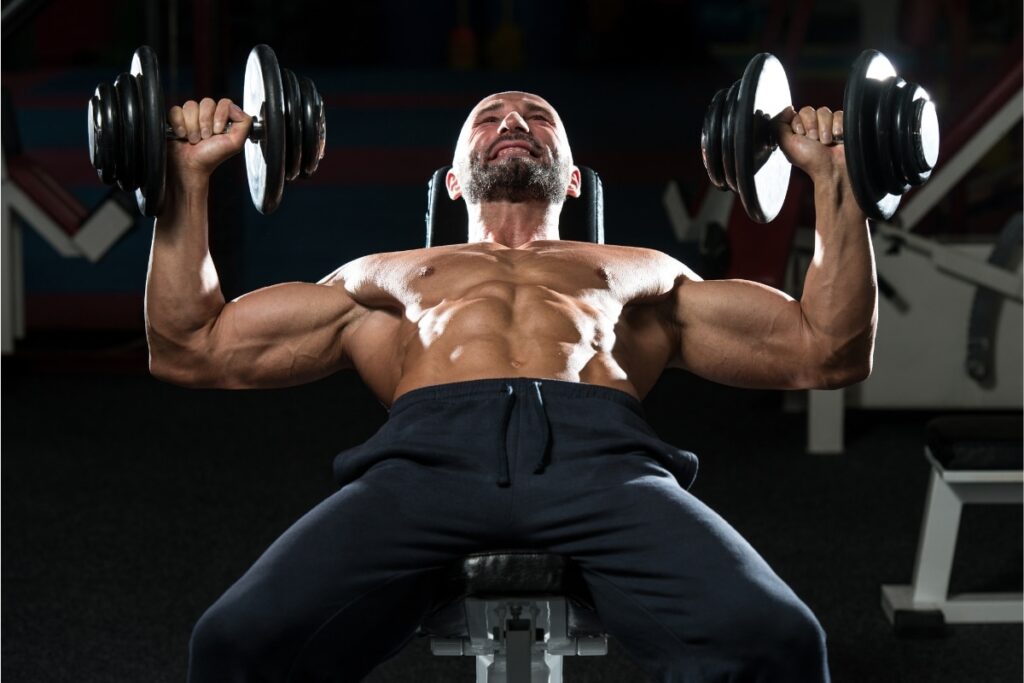The dumbbell bench press is an excellent exercise for building strength and muscle in your chest, shoulders, and triceps. In this article, we’ll cover everything you need to know about this exercise, including how to perform it correctly, what muscles it works, and some variations you can try. Let’s get started!
How to Perform the Dumbbell Bench Press
The dumbbell bench press is a relatively simple exercise to perform. Start by lying on a flat bench with a dumbbell in each hand. Then, bring the dumbbells up to your chest and position them, so your palms face your feet. Next, press the weights until your arms are fully extended, then lower them back to your chest. That’s one rep! Keep your core engaged throughout the exercise, and don’t arch your back.
Muscles Worked by the Dumbbell Bench Press
The dumbbell bench press is primarily a chest exercise but also works your shoulders and triceps. When performed with heavy weights, it can also work your legs and core as they help stabilize your body.
Dumbbell Bench Press variations
You can vary this exercise to keep things exciting and target different muscle groups. Here are just a few of the most popular variations:
Close Grip:
Bring the weights closer together so that your hands are only a few inches apart. This variation puts more emphasis on your triceps.
Wide Grip:
Move the weights farther apart so that your hands are nearly at shoulder width. The wide-grip dumbbell bench press puts more emphasis on your chest muscles.
Incline Bench:
Position yourself, so you’re lying on an incline bench (at an angle) rather than a flat bench. This is because the inclined dumbbell bench press targets your upper chest more than a traditional flat bench press.
Decline Bench:
Position yourself, so you’re lying on a decline bench (at an angle) rather than a flat bench. This is because the decline dumbbell bench press targets your lower chest more than a traditional flat bench press.
One Arm:
Perform the dumbbell bench press with one arm at a time instead of using both arms simultaneously. This variation allows you to focus on each side of your chest individually.
Seated:
Instead of lying on a bench, sit up tall with a weight in each hand and press from there. This variation is excellent for people with lower back pain as it takes stress off the spine.
Dumbbell Bench Press Volume
Now that we’ve covered some basics, let’s talk about how much volume you should do when performing the exercise. For muscle growth (hypertrophy), aim for 3-5 sets of 8-12 reps with 60-90 seconds of rest between sets. If you’re trying to increase strength (rather than size), go for 5-8 sets of 3-5 reps with 2-3 minutes of rest between sets using heavier weights.
And lastly, if you’re looking to maintain muscle mass and don’t want to add any additional volume, 2-3 sets of 8-12 reps will suffice—make sure you’re using enough weight that you can only complete those reps with good form (no cheat reps!).
Conclusion on the Dumbbell Bench Press
The dumbbell bench press is an excellent exercise for building strength and muscle mass in your chest, shoulders, and triceps—and there are many different ways you can vary the routine to target other muscle groups or emphasize different areas of your chest.
When performing the bench press for muscle growth, aim for 3-5 sets of 8-12 reps with 60-90 seconds of rest between sets; for strength, go for 5-8 sets of 3-5 reps with 2-3 minutes of rest between sets; and for maintenance, 2-3 sets of 8-12 reps will do the trick—make sure you’re using enough weight!
If you love bodybuilding, share this article on Facebook or Twitter so that others can learn more about building muscle.




